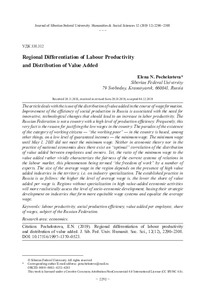Regional Differentiation of Labour Productivity and Distribution of Value Added
Скачать файл:
URI (для ссылок/цитирований):
https://elib.sfu-kras.ru/handle/2311/128434Автор:
Pochekutova, Elena N.
Почекутова, Е.Н.
Дата:
2019-12Журнал:
Журнал Сибирского федерального университета. Гуманитарные науки. Journal of Siberian Federal University. Humanities & Social Sciences;2019 12 (12)Аннотация:
The article deals with the issue of the distribution of value added in the course of wage formation. Improvement of the efficiency of social production in Russia is associated with the need for innovative, technological changes that should lead to an increase in labor productivity. The Russian Federation is not a country with a high level of production efficiency. Frequently, this very fact is the reason for justifying the low wages in the country. The paradox of the existence of the category of working citizens — “the working poor” — in the country is based, among other things, on a low level of guaranteed incomes — the minimum wage. The minimum wage until May 1, 2018 did not meet the minimum wage. Neither in economic theory nor in the practice of national economies does there exist an “optimal” correlation of the distribution of value added between employees and owners. Yet, the ratio of the minimum wage to the value added rather vividly characterizes the fairness of the current systems of relations in the labour market, this phenomenon being termed “the freedom of work” by a number of experts. The size of the average wage in the region depends on the presence of high value added industries in the territory, i.e. on industry specialization. The established practice in Russia is as follows: the higher the level of average wage is, the lower the share of value added per wage is. Regions without specialization in high value-added
economic activities will more realistically assess the level of socio-economic
development, basing their strategic development on industries that form more equitable wage systems and equalize the average wage В статье рассмотрена проблема распределения добавленной стоимости при формировании
оплаты труда. Повышение эффективности общественного производства
в России связывают с необходимостью инновационных, технологических изменений,
которые должны привести к росту производительности труда. Российская Федерация не является страной с высоким уровнем эффективности производства. Зачастую именно этот факт служит доводом для обоснования низкой заработной платы в стране. Парадокс существования в стране категории работающих граждан —
«работающих бедных» — основан, в том числе, на низком уровне гарантированных
доходов — минимальном размере оплаты труда. Минимальный размер оплаты труда до 1 мая 2018 г. не соответствовал прожиточному минимуму. Размер средней заработной платы в регионе зависит от присутствия на территории отраслей с высокой
добавленной стоимостью, т.е. от отраслевой специализации. Сложившая практика
в России такова, чем выше уровень средней заработной платы, тем ниже доля добавленной стоимости, приходящейся на оплату труда. Регионы, которые не имеют специализации в видах экономической деятельности с высокой добавленной стоимостью,
более реально оценивают уровень социально-экономического
развития, основывая
свое стратегическое развитие на отраслях, формирующих более справедливые системы оплаты труда и выравнивающих уровень средней заработной платы
Коллекции:
Метаданные:
Показать полную информациюСвязанные материалы
Показаны похожие ресурсы по названию, автору или тематике.
-
Designing of network planning system for small-scale manufacturing
Капулин, Д. В.; Русских, П. А.; Винниченко, М. В. (2018-05)The paper presents features of network planning in small-scale discrete production. The procedure of explosion of the production order, considering multilevel representation, is developed. The software architecture is ... -
The Production Potential of the Agroindustrial Complex of the Siberian Federal District – the Basis for the Development of the Food Market of the Region
Suslova, Yulia Yu.; Voloshin, Andrey V.; Суслова, Ю.Ю.; Волошин, А.В. (Сибирский федеральный университет. Siberian Federal University, 2017-11)This article analyzes production of the core types of agricultural products by the regions of the Siberian Federal District. In particular, the structure of crop areas of cereals, including wheat, oil-bearing crops, such ... -
Prospects of Medium Thickness Slabs Application in Technological Complex “Continuous Slab Casting – Hot Rolling Mill”
Solovyev, Alexander G.; Shitov, Michael V.; Drobny, Dmitry O.; Соловьев, А.Г.; Шитов, М.В.; Дробный, Д.О. (Сибирский федеральный университет. Siberian Federal University., 2014-05)The consideration was given to a transition to medium thickness slabs for complexes CCM-Plate Mill and CCM-Hot Rolling Mill. We used two examples, considering their technical characteristics, to show possible advantages ... -
Rethinking the Improvement of Medieval Cities in the Eastern Europe Through “Bone Causeways”
Yavorskaya, Liliya V.; Яворская, Л.В. (Сибирский федеральный университет. Siberian Federal University, 2020-07)Following the methodological scheme initiated in the Laboratory of Natural Sciences, the Institute of Archaeology of the Russian Academy of Sciences, a comparative study of unique phenomenon of medieval urban improvement ... -
Трансформация, круговорот лабильных веществ и продукционно-деструкционные процессы в озерных экосистемах
Лозовик, П.А.; Рыжаков, А.В.; Lozovik, Petr A.; Ryzhakov, Alexandr V. (Сибирский федеральный университет. Siberian Federal University, 2017-12)Для оценки трансформации веществ использовалось кинетическое уравнение для озерных систем: R= kτ/(1+kτe^((-1)⁄τ) ), где R – удерживающая способность, k – константа скорости трансформации, τ – период водообмена. Наименьшие ...

